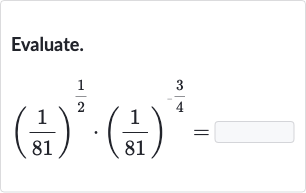AI tutor
Full solution
Q. Evaluate.
- Problem Understanding: Understand the problem.We need to evaluate the expression . This involves working with exponents and understanding the properties of exponents.
- Exponent Properties: Apply the properties of exponents.When multiplying expressions with the same base, we add the exponents. So, we can rewrite the expression as .
- Exponent Subtraction: Subtract the exponents..So, the expression now is .
- Base Evaluation: Evaluate the base.The base is , which is the same as .
- Negative Exponent Rule: Apply the negative exponent rule.A negative exponent means we take the reciprocal of the base. So, is the same as .
- Fourth Root Evaluation: Evaluate the fourth root of . The fourth root of is because . So, the final answer is .

